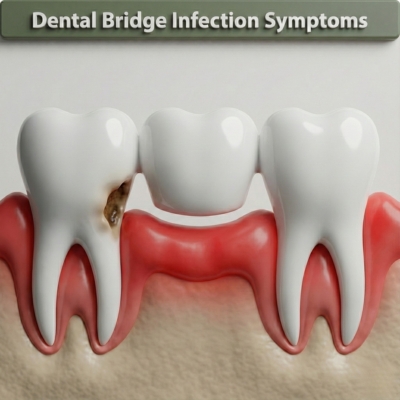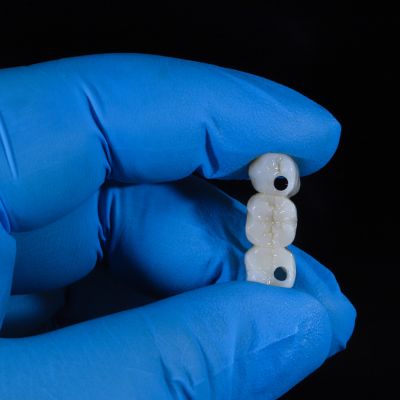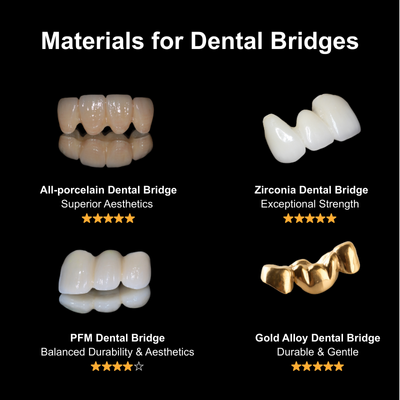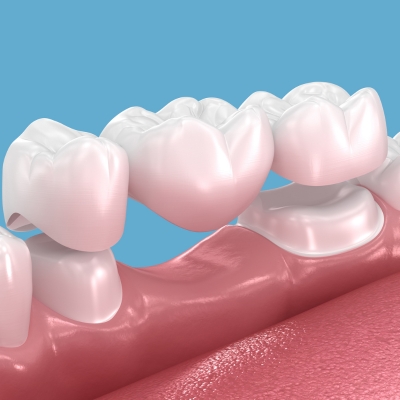News + Articles
How to Fix a Loose Dental Bridge at Home
A loose dental bridge cannot be permanently repaired at home, but you can stabilize it safely for 24–48 hours to prevent damage to your abutment teeth.
A quick temporary fix reduces the risk of the bridge fracturing, trapping bacteria, or being accidentally swallowed.
Before your appointment at Restoration Dental OC, follow this simple 3-step protocol using a temporary dental cement (best option) or a denture adhesive (emergency-only; never use super glue).
Quick Answer
- Clean: Gently remove debris and old cement from the bridge and abutment tooth.
- Dry: Isolate the area to prevent saliva contamination, which causes bond failure.
- Secure: Apply a pea-sized amount of cement and bite down gently to seat the bridge.
⚠️ 4 Dangerous Mistakes That Ruin Teeth
In our experience providing dental services at Restoration Dental OC, we often see patients cause irreparable damage by using the wrong materials.
To protect the integrity of your dental bridge, avoid these dangerous mistakes:
1. Never Use Super Glue:
Household glues contain toxic chemicals (cyanoacrylate). Additionally, super glue creates a bond that is too strong and uneven, which can damage the bridge and the natural teeth, often requiring the dentist to drill the bridge off and extract the abutment tooth.
2. Do Not Force the Bridge:
If the bridge does not fit smoothly back into place, do not force it. This can fracture the porcelain or damage the abutment tooth underneath.
3. Avoid DIY Filing:
Do not try to file or alter the surface of the bridge to make it fit, as this will destroy the restoration and ruin your bite alignment.
4. Do Not Sleep with a Loose Bridge:
A loose bridge can dislodge during sleep. This poses a risk of swallowing the restoration or, more critically, inhaling it (aspiration), which blocks your airway.
To ensure safety, remove the restoration before bed and store it in water to maintain material hydration until your professional recementation.
What to Do Immediately If Your Dental Bridge Feels Loose
Before applying any temporary repair material, perform a quick safety check.
Stop Chewing on That Side: Avoid putting pressure on the area immediately to prevent the bridge from warping.
Check the Stability: Gently touch it with your tongue. If it is loose on one side, do not wiggle it, as this can damage the surrounding teeth.
Inspect for Debris: Check if food is trapped in the area beneath the bridge.
How to Fix a Loose Dental Bridge at Home (Temporary)
If your bridge is moving but hasn’t fallen out, or if you need to re-seat a fallen bridge temporarily, follow these precise steps.
This process helps secure the bridge in place to maintain aesthetics and function for a short period.

Step 1: Remove, Clean, and Debride
Proper preparation is essential for the temporary repair material to hold effectively.
Assess Removal: Remove the dental bridge only when it is fully detached or extremely loose, and avoid removal if it remains attached on one side.
Soak to Soften: If the old cement is hardened and stubborn, soak the bridge in warm water for 5–10 minutes. This helps soften the material so it can be removed safely without scraping.
Remove Debris: Use a toothpick or dental floss to gently dislodge large chunks of old cement from inside the bridge.
Wash: Use a soft-bristled brush and warm water to clean the bridge thoroughly.
Prep the Teeth: Brush and floss the abutment teeth and gum line to remove any debris.
Step 2: Isolate and Dry
Saliva contamination is the primary cause of temporary repair material failure. You must create a completely dry environment.
Block Saliva Flow: Place sterile gauze between the cheek and the gum line to absorb saliva and isolate the abutment teeth.
Dry the Surfaces: Thoroughly wipe the abutment teeth and the surrounding gum tissue until they are moisture-free.
Prepare the Bridge: Ensure the hollow internal surface of the bridge crown is completely dry.
Step 3: Apply Temporary Material
Select the optimal temporary repair material for your situation by comparing the hold duration and material properties in the table below.
Material Type | Product Examples | Hold Time | Best For |
Denture Adhesive | Poligrip, Fixodent | 8–24 hours | For emergency use only; provides weak tack, not a true bond. |
Temporary Cement | Dentemp, Recapit | 24–72 hours | Best option; strong, safe, and designed for short-term dental use |
Application Instructions: Carefully apply a pea-sized amount (approx. 0.5g) of temporary dental cement directly onto the hollow internal surface of the bridge crown.
If cement is unavailable, you may use a dental adhesive as a short-term alternative (8 – 24 hours). Do not overfill the crown, as excess material causes gum irritation and prevents the bridge from seating correctly on the abutment teeth.
Step 4: Gently Reseat the Bridge
Align: Carefully place the bridge back over the abutment teeth, using a mirror to ensure it is positioned correctly.
Seating: Bite down gently but firmly to push the bridge into its final position.
Crucial Holding Phase: Hold your jaw firmly shut for 60–120 seconds. Do not wiggle, shift, or grind your teeth during this time, as even micro-movements will break the bond before the cement sets.
Cleanup: Once set, wipe away any excess material that squeezes out.
Dietary Warning: This temporary fix is not stable enough for chewing hard or sticky foods. Stick to a soft diet to keep the bridge secure (e.g., Yogurt, Smoothies, Mashed Potatoes).
Video Guide: How to Cement a Loose Bridge
To enhance your understanding of the repair process, the video below illustrates the professional protocol for preparing and reseating a dental bridge.
Note on Materials: Although the demonstration uses clinical-grade materials (IRM/TempBond), the application techniques and safety steps remain identical when using over-the-counter temporary dental cement (like Dentemp) at home.
Video Timeline & Key Safety Protocol:
- [00:27] Material Preparation (Dosage & Ratio).
- [01:03] Mixing the Cement (Viscosity Control).
- [01:52] Applying Cement/Material to the Bridge.
- [02:25] Seating on Abutment Teeth (Gentle Pressure).
- [02:40] Removing Excess Cement (Crucial Hygiene Step).
How to Manage a Dental Bridge Loose on One Side
A common and precarious situation occurs when the dental bridge is loose on one side but remains firmly attached to the other abutment tooth. This creates a dangerous “cantilever” or leverage effect.
Do Not Pull It Out:
If the bridge is stuck on one side, do not attempt to pull, yank, or force the bridge off. Doing so can fracture the healthy tooth structure of the remaining secure abutment.
Do Not Apply Adhesive:
You cannot effectively clean or dry the area beneath the bridge that is partially attached. Adding material often traps food particles and bacteria, accelerating decay.
Immediate Action:
Stop chewing on that side immediately. The up-and-down movement of the loose side acts like a lever, placing immense stress on the remaining abutment tooth. Keep the area clean using a water flosser and see a dentist promptly.
4 Distinct Signs of a Loose Bridge
Before identifying the exact problem, you must confirm the structural integrity of the restoration. A loose bridge presents with four specific symptoms:
- Visible Movement: The bridge shifts or moves when you apply pressure with your tongue or finger.
- Abutment Sensitivity: You feel sharp pain in the natural teeth supporting the bridge when consuming hot or cold beverages.
- Bite Irregularity: Your bite alignment feels uneven, or the bridge produces a clicking sound during chewing.
- Halitosis or Bad Taste: A persistent bad taste or smell indicates trapped food particles decomposing beneath the bridge, signaling tooth decay.
Why Did My Dental Bridge Come Loose?
Understanding the root cause is essential for preventing future dental issues. A dental bridge typically loosens due to three primary factors:
Cement Failure: The dental cement holding the bridge can wash out over time (typically after 5 to 15 years), causing the seal to break and the restoration to detach.
Recurrent Decay: Poor oral hygiene allows bacteria to seep underneath the bridge, causing tooth decay on the abutment teeth. This weakens the biological structure holding the bridge in place.
Occlusal Trauma or Habits: Conditions like bruxism or biting on hard objects create excessive force that fractures the cement seal and dislodges the bridge.
Professional Repair: What to Expect at Restoration Dental OC
When you visit Dr. Ronald Pham, a qualified dental professional at Restoration Dental OC, we perform a comprehensive exam (often including digital X-rays) to assess your bridge and abutment teeth.
This helps us determine the best long-term solution:
Permanent Re-cementing: If the bridge is intact and the abutment teeth are healthy, we can simply clean and re-cement the bridge with professional-grade bonding agents for a secure, lasting hold.
Bridge Replacement: If the bridge is fractured or fits poorly due to bone loss, a new dental bridge may be necessary to fully restore function and aesthetics.
Treatment of Underlying Decay: We must treat any decay found underneath to protect the supporting structure before re-cementing the bridge.
Implant Solutions: If the underlying tooth has failed, we may recommend a dental implant as a permanent solution to replace missing teeth.
At Restoration Dental OC, we prioritize a gentle dental approach, ensuring you are pain-free and comfortable throughout the repair process.
Frequently Asked Questions
Can a Loose Bridge Be Fixed?
Yes, in many cases. If the bridge is structurally secure and the abutment teeth are healthy, a dentist can easily clean and re-cement it.
Can I Reuse My Old Bridge?
Yes, often. A dental bridge can be removed and recemented if the porcelain is not fractured and the fit remains accurate.
How Long Can I Leave a Loose Bridge?
You should not leave a bridge loose for more than 24 to 48 hours. A loose bridge allows food and bacteria to enter gaps, leading to rapid decay of the natural teeth underneath.
What If I Swallow My Dental Bridge?
If the dental bridge dislodges and is swallowed, seek medical attention immediately to ensure it passes safely. Afterwards, you will need to see a dentist to restore the missing teeth.
Schedule Your Gentle Dentist Assessment Today
Don’t let a loose bridge cause you panic. At Restoration Dental OC, we specialize in gentle, judgment-free repairs.
We can often save your bridge if you act fast. Call us now to secure your smile and avoid expensive replacements.

Dr. Ronald Pham, DDS, is a Doctor of Dental Surgery who graduated from the USC Ostrow School of Dentistry in 2015. With over 8 years of experience in restorative dentistry, including dental implants, crowns, bridges, fillings, root canals…
Dr. Pham has restored the smiles of +2,000 patients and is committed to providing professional dental care focused on patient comfort. He achieves this by combining a welcoming space and state-of-the-art dental technology.
Book Your Appointment Now
Related Articles

Guaranteed Smiles!
As a premiere dentist office in Orange CA, we will always make sure that your experience is memorable, friendly, and professional. We strive to meet your highest expectations in every way imaginable, from your very first interaction with our office staff, to the quality of treatment you receive. We don’t take our patients’ trust for granted, and will promise to over-deliver with your best interest in mind. So give us a call today, and experience our first-class service!
Insurance
Accepted
We proudly accept most dental insurance plans, and welcome cash patients as well. Call us today for more information.
$199
Special
New to our dental office? Take advantage of our New Patient special offer with x-rays, exam, and full report of findings.
Extended
Hours
Do you have an emergency? Need to see us a little later or earlier? Let us know. We can be flexible to meet your busy schedule!










